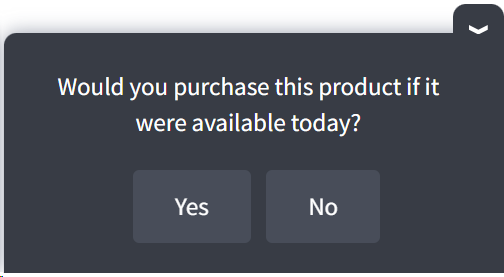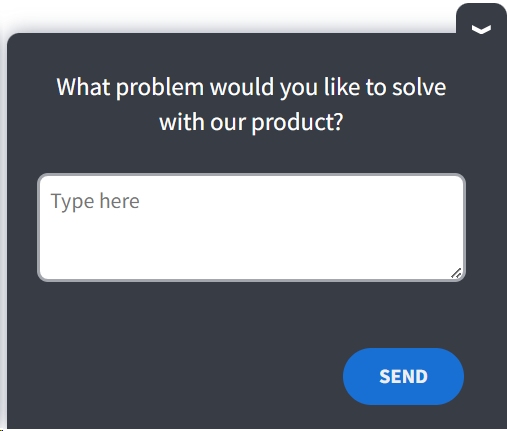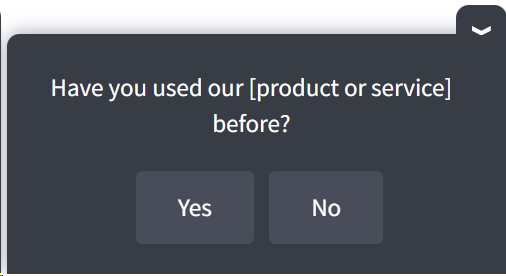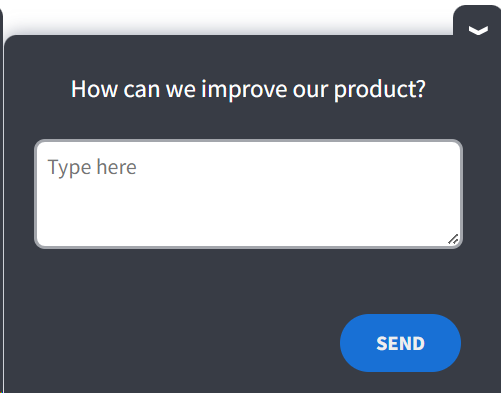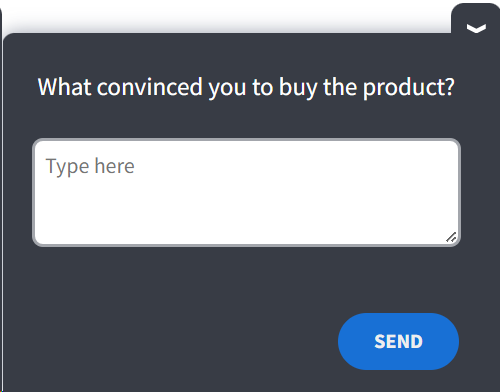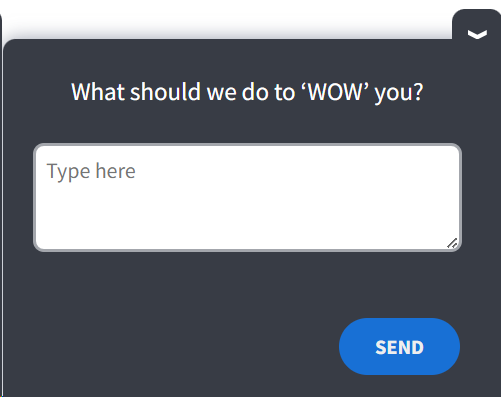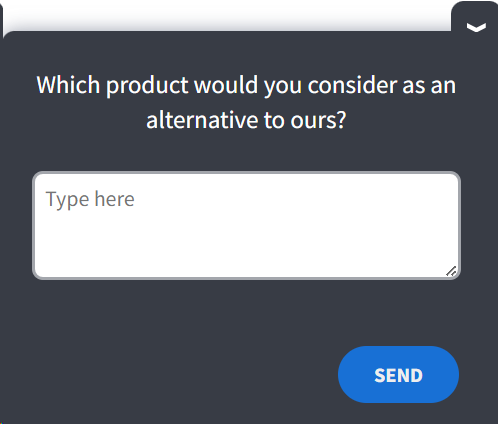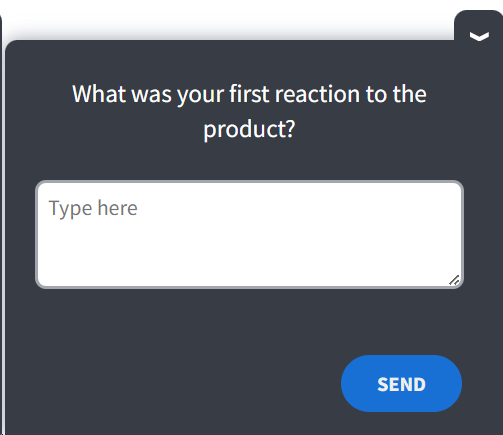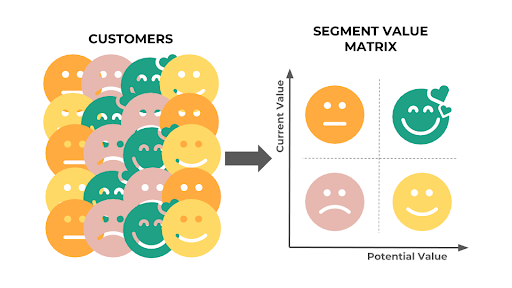Echoing Steve Jobs' perspective, the journey of product development must commence from the customer experience, leading back to the technology, not the other way around. This emphasizes the importance of understanding customer needs and preferences at every phase of your product's lifecycle, ensuring the final outcome resonates with your target audience.
What is the most straightforward and effective method for gathering insights from users? Utilize product feedback surveys and questionnaires. This guide is dedicated to empowering you with the knowledge to employ these tools effectively.
We've meticulously assembled comprehensive insights on harnessing product feedback, enabling you to enhance and refine your offerings throughout their lifecycle. Here's a glimpse of what this guide offers:
- Strategies for capturing user feedback at various stages using product feedback tools.
- Success stories of brands that have transformed their products based on customer feedback.
- A compilation of expertly crafted, ready-to-use product feedback questionnaire items, available at no cost, to kickstart your feedback collection process immediately.
Let's dive in and explore how to leverage product feedback surveys to their fullest potential.
100+ Ready-to-Use Product Feedback Survey Questions for Different Scenarios
Want to create great product feedback surveys that gather the right data for you? Then bookmark this guide and save this specially curated list of questions for every stage. We have grouped the questions based on different scenarios. A scenario can be applied at various stages of your product cycle.
Just pick the scenario and choose the questions that fit that particular stage where you want to collect the product feedback. You can tweak the questions as required.
If you want to cover more than one scenario in the same survey, you can add multiple questions to it. Just remember to keep it short and simple for the respondents.
1. Planning or Releasing New Updates
A. Polls
- Which feature do you want us to build next? (Single answer type)

- What is your favorite feature in the [product name]? (Free-text)
- Do you think we should add [feature] to the [website, app, or product name]? (Y/N)
B. Product Opportunities Surveys
- Which feature do you think will help to make the product better? (Single answer type)
- Would you purchase this product if it were available today? (Y/N)

- Would you purchase the product at [price]? (Y/N)
- According to you, what should be the price for this product? (Free-text)
- How would you feel if we discontinued this feature? (Likert scale)
- Have you seen any product with [feature name]? (Y/N)
- Would the implementation of [this feature] increase the usability of the [App name] (Y/N)
- What problem would you like to solve with our product? (Free-text)

C. After Releasing the New Product or Update
- How would you rate this new feature? (Rating scale 1-5)
- Please let us know how we can further improve this feature. (Free-text)
- Have you used our [product or service] before? (Y/N)

- How likely are you to recommend [product name] to your friends and colleagues after implementing [feature name]? (NPS Scale)
2. Testing Usability After Product Demo or Usage
A. First Impression Test for Testing Usability
- How easy is our product to use? (Likert scale or rating scale)
- What was your initial impression of the product? (Free-text, Likert Scale)
- How easy was it to navigate the product? (Likert scale)
- What are the things that you liked the most about the product? (multiple choice)
- What is the one thing that frustrated you most about the product? (Free-text or Single answer type)
- How can we make the product better? (Free text)
B. Five-Second Test
- What function do you think this product does? (Free text)
- What's your first impression of the product? (Free text)
- What grabbed your attention? (Free text)
- What words or sentences can you recall?
- What are the main elements you can recall?
- What was your impression of the UI? (Free text)
C. Mapping Ease of Use
- Customer Effort Score (CES): how easy did [product name] make it for you to solve your issue? (Likert scale)
- How strongly do you agree or disagree with the following statement: This product is easy to use. (Likert scale or rating scale 1-5)
- How can we make the product better? (Free text)
- What problems did you encounter while using our [product]? (Free text)
- What was the most difficult thing about this [product]? (Free text or single answer type)
- How easy did we make it to solve your problem? (Likert scale)
- What feature did you expect but not find? (Free text)
- Overall, how satisfied were you with the product? (Likert scale or rating scale)
- How could we make [this product] easier to use? (Free text)
3. Overall Product Experience
- Please rate the following aspects of the product as per your experience: (Matrix question)
- How satisfied are you with the product? (Likert scale or rating scale)
- According to you, what are the best features of [product name]? (Free-text)
- What difficulty did you face while using the product? Please specify. (Free-text)
- How can we improve our product? (Free-text)

- How can we make the product better for you? (Free-text)
- What are the things that you want to improve in the product? (Free-text)
- Please rate your overall experience with the product. (Rating scale 1-5)
- What goals are we helping you achieve? (Free-text)
- What changed for you after you started using our product? (Free-text)
- How are you planning to use [product or service]? (Free-text or single answer type)
- What convinced you to buy the product? (Free-text)

- Which of the following words would you use to describe our product? (Multiple choice)
- Which three features are the most valuable to you? (Free-text)
4. Product Satisfaction Surveys
- Overall, how satisfied were you with our [product name]? (Likert scale or rating scale 1-5)
- If the response is negative (1-3), Sorry to hear that! How could we improve?
- If the response is positive (4-5), What do you love about [product name]?
- Do you feel our [product or service] is worth the cost? (Y/N)
- How likely are you to buy again from us? (Likert Scale)
- What would persuade you to buy our [product name]? (Free text)
- Thanks for [taking action]! How are you planning to use [product or service]? (Free text or single answer type)
- What should we do to ‘WOW’ you? (Free text)

- How would you feel if you couldn’t use [Product Name] anymore? (Free text)
- What would persuade you to use [Product Name} more often? (Free text)
5. NPS Surveys
- What is the likelihood that you would recommend [company or product or app] to a friend or colleague? (NPS scale)
- If the answer is (0-8), what is the reason for your answer? (Free text)
- If the answer is 9-10), what are the aspects that you like the most? (Free text)
- How likely are you to buy again from us? (Likert scale)
6. Competitive Analysis
- Which other options did you consider before choosing our [Product name]? (Free text)
- Have you seen any product with [feature name]? (Y/N)
- According to you, which brand best fits each of the following traits. (Free text or single answer type)
- Based on its current features and attributes, would you recommend [product name] to others? (Y/N)
- Rate our product/service according to the following: (Matrix question)
- Which product would you consider as an alternative to ours? (Free text)

- Of all the brands offering similar products, which do you feel is the best brand? (Free text or single answer type)
- How would you compare our products to our competitors’? (Rating scale)
- Why did you choose to use our [product] over other options? (Free text)
- Compared to our competitors, is our product quality better, worse, or about the same? (Free text)
- Why did you choose our product rather than a competitor’s? (Free text)
7. Mapping Customer Preferences
- Do you use the [product name]? (Y/N)
- How long have you been using the product? (Single answer type)
- How long have you had the product? (Single answer type)
- How often do you use the product? (Single answer type)
- How likely are you to purchase a product from us again? (Likert scale)
- Please rate the following aspects of our product based on their importance to you. (Rating scale)
- What is the most important value our product offers to you? (Free-text or single answer type)
- Which of the following features do you use least? (Multiple answer type)
- How well does the product meet your needs? (Likert scale)
- Rate the factors that affect your buying decision for [product]. (Matrix question)
- Do any other factors affect your buying decision for this product category? (Free text)
- According to you, in which area is this product/service lacking the most? Specify below. (Free text)
- Have you purchased from this brand before? (Y/N)
- Do you currently use the product of this brand? (Y/N)
- What problem would you like to solve with our product? (Free-text)
Bonus Read: Customer Journey Mapping Guide: Examples & Templates
8. Mapping Customer Reservations or Surveying Exiting Customers
- What's the one thing that nearly stopped you from buying from us today? (Free-text)
- Did you find what you were looking for? (Y/N)
- What would convince you to buy the product? (Free-text)
- What important features are we missing? (Free-text)
- What is preventing you from achieving your goal? (Free-text)
- What is your greatest concern about [product]? (Free-text)
- Do you feel our [product or service] is worth the cost? (Y/N)
- What nearly stopped you from buying? (Free-text)
- Have you started using other similar products? If yes, what made you choose that product? (Free-text)
Bonus Read: 25 Best Online Survey Tools & Software
9. Unsolicited Feedback Form / General Feedback or Suggestion Form
- How can we improve our product? (Free-text)
- Help us make the product better. Please leave your feedback. (Free-text)
- Have suggestions or feedback? We would love to hear from you. (Free-text)
Bonus Read: Best Customer Feedback Software & Tools
10. Identifying Bugs or Issues / Collecting Data for UI/UX Optimization
- How can we improve our product? (Free-text)
- What are the things that you want to improve in the product? (Free-text)
- Is there any feature that is missing from our product? (Free-text)
- How can we make this product better? (Free-text)
- What’s the one feature our product is missing? (Free-text)
- What are your main concerns or questions about [product or service]? (Free-text)
- How strongly do you agree/disagree with the following statement: This [product's/ tool's/ software's] capabilities meet my requirements. (Likert scale or rating scale)
11. Early Feedback
- Rate the product based on the following aspects: (Matrix question)
- What was your first reaction to the product? (Free-text)

- What do you like the most about the product? (Free-text)
- Is there anything that we can improve? Please specify. (Free-text)
- What was your initial impression of the product? (Free-text)
- Based on its current features and attributes, would you recommend [your brand name] to others? (NPS scale)
12. Surveying / Targeting Churned Customers
- What are your main reasons for leaving? (Free-text)
- Please rate your overall experience with the product. (Rating scale or Likert scale)
- What is the likelihood that you would recommend [company or product or app] to a friend or colleague? (NPS scale)
- What is the reason for your answer? (Free-text)
- How easy is our product to use? (Likert scale)
- What important features are we missing? (Free-text)
- Which of the following words would you use to describe our product? (multiple choice)
Why Is Product Feedback Important?
The answer - is because your products need to evolve with time and customers. And to make sure you are headed in the right direction, you need to hear what your customers are saying.
Product feedback plays a vital role at different stages of your product cycle.
From helping in coming up with new product ideas and validating their efficacy to fueling after-release optimization, you need customer insights to deliver what they want from you.
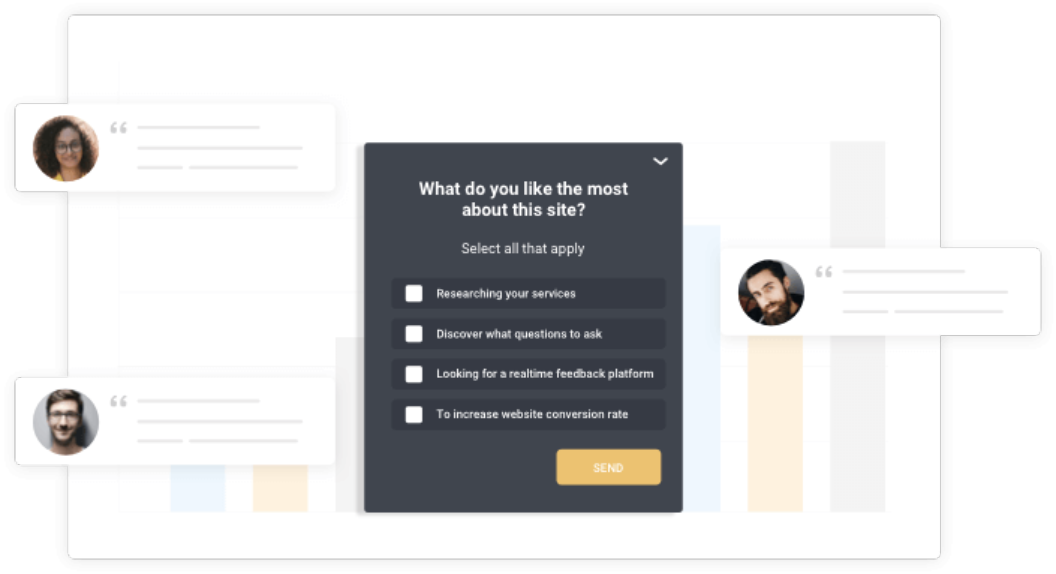
Here’s a look at the uses of product feedback in detail:
1. To Design and Improve Product Roadmaps
A product roadmap summarizes your strategy and planning process for building the product or releasing new updates on a time scale. Each stage may contain one or more ideas that you plan to work on.
With limited resources and time, how will you prioritize each of them? By collecting product feedback.
Using simple polls, targeted surveys, or Q&A boards can reveal which updates or products should go to the next development stage. It will also help you add new ideas that your customers might be looking forward to but you may have missed including in the roadmap.

You can track customers’ demands and preferences and release new updates that appeal to them with a data-backed approach.
2. To Build Products That Sell
Suppose you have a product idea that you think will improve sales and increase your customer base. What should be the next step - To start building it or research its demand among your audience?
Product development is a lengthy and arduous process. It requires planning, capital, and iterations. That's why it is crucial to research to back up your ideas.
Using product opportunity surveys, you can cement new ideas with actual customer feedback data, pinpoint issues with your current products, do some competitive research, and find out about your customers' interests.
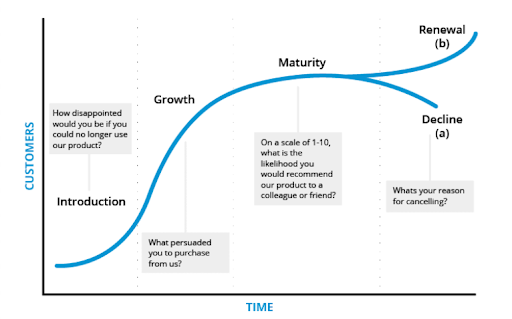
With this feedback, you can make necessary changes to your initial design and build a satisfying product experience. It provides the power to explore customers' problems and implement the solutions directly into your product development cycle.
Bonus Read: Complete Guide to User Research
Case Study - Twilio
At Twilio, understanding customers’ needs and problems is the backbone of their product development strategies. They use Qualaroo Nudges™ to conduct surveys for user testing, collect product feedback, brainstorm new ideas, map customers’ expectations, and more.
With targeted product feedback surveys, they can test the validity of their ideas and share the feedback data with over 18 teams so everyone can benefit from it. They use product feedback surveys to connect directly with the customers to collect feedback, prioritize different hypotheses, and make data-backed decisions at every stage of product development.
3. To Cater to Different Customer Segments
Not all customers are the same. Their preferences and interests change with demographics and psychographic factors. As a result, your best-selling product for one segment or location may not appeal to another.
Then, how will you make sure that you offer the right kind of product to the right customers?
By asking them what they want or don't want.
Product feedback surveys let you identify different audience segments and design products that cater to each of them. You can release location-specific products or include features that benefit different customer segments. You can also launch variants of the same product with slightly different features based on the feedback to target specific locations, age groups, customer types, and more.
Case Study - Udemy
At Udemy, user feedback drives product innovation and marketing strategies. They use product feedback surveys to understand incoming traffic sources and identify different audience segments to allocate their advertising budget appropriately.
By segmenting customers using survey data, they discovered that students outside English-speaking countries were also enrolling in courses taught in English.
From this insight, they introduced a new feature - automatic captioning in English courses so the users can easily understand them. It has helped Udemy to expand its reach to students around the world. They continuously collect user feedback using this feature to run timely product optimizations.
4. To Measure Customer Satisfaction
Put the microphone into the customer's hands and let them speak their mind.
Measuring customer satisfaction can help you understand how happy your customers are with your products and services. It also lets you ask follow-up questions to get deeper insights.
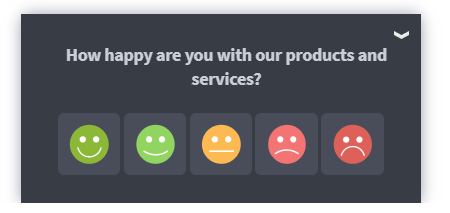
If they say they are happy, you can explore the reason behind it and employ the same ideas to other products and optimize them. If they say they are not satisfied, you can uncover their pain points and issues with personalized follow-up questions. Then, use the feedback to make the required changes and improve their product experience.
Case Study - Belron
Belron, a leading automotive windshield manufacturer, aims to provide the best and easiest experience to every customer. It maintains an NPS score of 80 using customer survey feedback. Their customers include people who are looking to replace the windshield on their vehicles. So, Belron gathers insights by collecting NPS through product feedback surveys from previous customers' experiences to provide satisfactory solutions to new customers.
They also target leaving customers using exit-intent surveys to understand what is missing from their website. The responses are then analyzed with advanced techniques like sentiment analysis and text analytics to uncover the points of friction and frustration.
The feedback is filtered through every department to improve both online and in-store experiences. Customers' satisfaction with the service and product is reflected directly in their sky-high NPS score of 80.
Bonus Read: Best NPS Software
5. To Promote Brand Advocacy and Retention
Better products = happy customers, which ultimately equates to brand promotion.
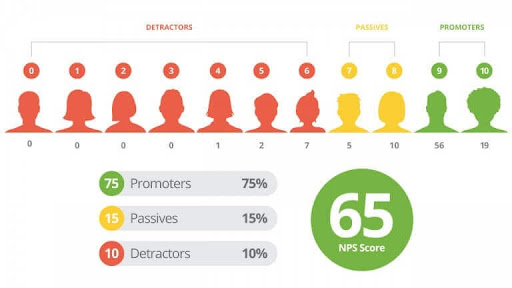
86% of the customers with excellent purchase experience are likely to buy from the same company again. If your products provide the solutions that your customers are looking for, they will return to you again and again.
Product feedback can help you identify satisfied customers, brand advocates, and promoters. It will let you understand what makes your products stand out from the competition. Leverage that data to deliver a better customer experience and increase brand awareness.
- You can reach out to these customers to ask for store ratings or Google reviews.
- Add their testimonials and success stories to your website or app page to increase brand credibility.
- You can also launch an affiliate program to motivate them to promote your brand and products.
Case Study - Airbnb
Airbnb, the world's leading vacation rental website, is all about experiences, and testimonials play an essential part in connecting guests with hosts. Airbnb uses customer stories and testimonials on its website to build trust among new visitors.
After their stay, the customers can leave feedback about their lodgings. The reviews and ratings help hosts make changes improve their listings, and allow new visitors to find the right place for their vacation. The entire cycle acts as a perfect driver to bring in more business for the hosts and Airbnb.

6. To Generate Leads
Every product you build should provide value to the customers for their time, effort, and money.
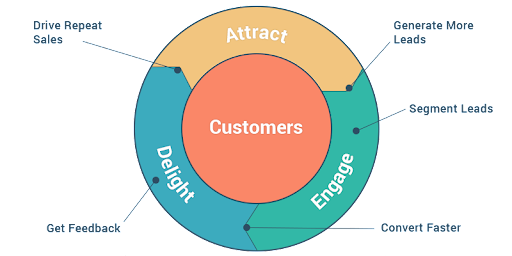
There are plenty of ways to use product feedback to bring in new customers:
- Add positive product feedback and reviews to your website or product page to attract visitors because nearly 9 out of ten people read online reviews before making a purchase.
- Mine through the product feedback to find the most satisfied customers. Reach out to these customers to create case studies and add them to your website. You can leverage advanced data mining techniques like Sentiment Analysis offered by various tools such as Qualaroo to make the process faster.
- As mentioned earlier, you can also launch incentivized referral programs to motivate your buyers to bring in more customers. Use product feedback surveys to identify such people and make them your brand's promoters.
Bonus Read: Best Lead Generation Tools
Case Study - Adobe
Adobe's website is one of the prime examples of using product feedback and success stories to showcase the might of its products. It offers products for digital marketing, designing, Business Intelligence solutions, and others. Its testimonial page is beautifully designed to display how each product can help you out.
In addition, they have categorized customer stories according to product type, and each category has its sub-sections. So, when you land on their page, you can find testimonials about the product you are looking for and quickly browse other product types to explore their benefits for your business.
When and Where to Use Product Feedback Survey
Product feedback surveys are one of the most efficient ways to hear customers' complaints, delights, and grievances. They are easy to deploy, and you can target your core audience to ensure higher data reliability and accuracy.
However, you cannot distribute your product feedback surveys whenever you want. You need strategic planning to target users at the precise moments to collect contextual and accurate data.
To help you with this, we have listed the different stages in your product cycle and the associated scenarios that may arise at each stage to collect different types of feedback.
1. When You Are Planning to Add New Products, Features, or Functionalities
Scenarios
Releasing new updates
Exploring product opportunities
Researching new products
Doing competitive analysis
Mapping customers' preferences
- If you have multiple features in your list, add a simple poll to your website or app to collect user votes. You can also send it via email or embed it on your social media channels.
- Or, you can ask the customer which features they want in the product by using a simple free-text form on your website, app, or product. It will let you collect new ideas.

Once the votes are in, you can prioritize the updates based on the number of votes to each feature. It will directly show you the most anticipated feature. The best people to ask for this kind of product feedback are your verified customers because they are already using the product.
Set the product feedback survey to appear to only verified customers using the suitable targeting options.
If you are brainstorming ideas about a new product, start with audience segmentation and understand each segment's expectations of your brand.
Case Study - Apple
Apple continues to garner the best customer satisfaction ratings because the company lets customer feedback lead its innovations. In addition, they have an official Apple support account on Twitter with a turnaround time of fewer than 12 hours, considering the thousands of messages they receive every day.
They also send post-purchase CSAT surveys via email to gauge customer's purchase experience and satisfaction with the product.
NPS surveys are also a part of their feedback management system. They channel this feedback data into their product cycle and marketing efforts to deliver what customers want. For example, recently, they measured the satisfaction level of their Apple Watch among the customers, which showed an overwhelming 97% approval rating.

2. Right After the Product Goes Live (Early Feedback)
Scenarios
Collecting early Feedback
Testing usability
Mapping customer preferences
Gauging product experience
Checking for issues or bugs
Looking for suggestions
When your product gets released, it is essential to collect early feedback from the first users. For this, add a product feedback questionnaire to collect user feedback at various touchpoints.
- Show the survey after the customer has used the product for a specific interval of time, say, 10-20 minutes.
- Set the survey to appear after the user interacts with crucial elements such as the billing section, order placement tab, navigation menu, or help guide.
- Gauge the usability by using a general product feedback survey for all users. It will also help to map the overall experience of each customer segment.
- Add a simple feedback form to the product to prompt unsolicited feedback and suggestions.
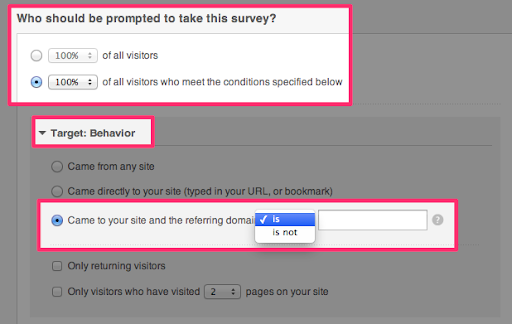
3. After Presenting the Product Demo
Scenarios
Collecting early Feedback
Testing usability
Mapping customer preferences
Gauging product experience
Checking for issues or bugs
Looking for suggestions
The product demo is one of the best ways to test its usability. Embed the product feedback survey into your product demo to collect valuable insights. Ask for product feedback as soon as the demo is complete.
You can also add a small lead generation form before the product demo and then send the product feedback survey to the users via email.
- You can ask how easy it was for the user to navigate the product.
- Ask them to report any broken paths, issues, or bugs.
- Gauge how satisfied they are with the product using CSAT ratings and scores.
- Ask them to choose the ideal price they would pay for the product after using the demo. (Pricing analysis)
- You can also use the five-second test to check the usability while they are using the demo.
- Collect ideas about the essential features that might be missing from the demo.
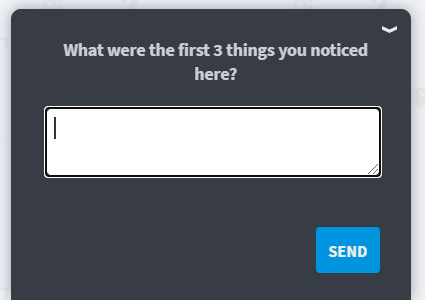
4. Right After the Customer Buys the Product
Scenarios
Competitive analysis
Gauge customers’ purchase preferences
Collecting CSAT scores
Ask for feedback just after the customer places the order to undertake competitive analysis and customer preference mapping. For example, you can probe the reason that helped the customer make their decision. Also, which other products did they consider before buying this product?
- Show the product feedback survey after the customer places the order on the website or app to gauge their interest and preferences.
- You can also send the product feedback survey via mail after 15-20 minutes of order confirmation.
- It will let you uncover any possible issues with your checkout process to reduce cart abandonment.
Case Study - Lalamove
Lalamove, an Asian logistics company, uses customer feedback to understand user preferences and problems. They use survey-based feedback loops across their organization to know how happy customers are with a specific feature and what needs to be improved within their app.
It also helps them uncover the most effective channels to bring in new customers. Using Qualaroo survey insights in their marketing, development, and other teams, they have experienced a growth rate of 20-30% each month across 110 cities.
5. When the Customer Starts Using the Product, i.e., Getting Feedback on the Existing Product
Scenarios
Measure overall product experience
Customer satisfaction evaluation
Collect data for optimization
Collect NPS score
Explore product opportunities
Who better to give you the targeted product feedback than the actual users?
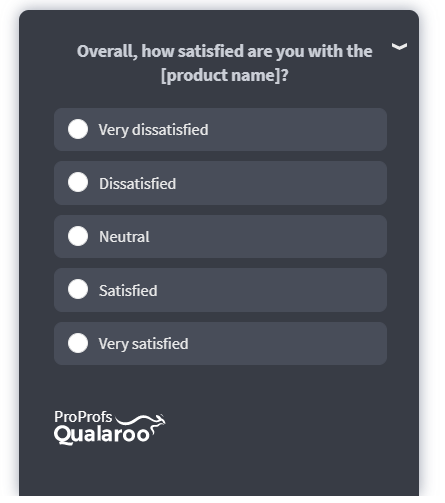
Target your verified users at different intervals during the product usage to evaluate the efficiency and effectiveness of the product.
- If you have a SaaS-based product, embed the survey directly into the product. You can also send the surveys via email or SMS.
- Show the surveys after one week, three months, and six months of product usage to collect and track customer satisfaction scores during this period. If the emotions change to negative with time, you can quickly address the customer's grievances and take the required action.
- The intervals can vary depending on the scope of your products and services. Choose two or three intervals to collect feedback about customers' overall product experience.
- You can also target the current users to collect ideas about new planned updates and uncover issues.
- Another option is to add a non-obtrusive feedback sidebar on every page or a feedback form to the 'Contact Us' section.
These simple steps will help in rapid product optimization and customer retention.
6. If a Customer Stops Using the Product
Scenarios
Mapping overall product experience,
Customer retargeting
Finding issues and customers' fears
Churned customers are a direct loss to your revenue stream. Collecting feedback from such customers will help you improve your product and give you insights to retarget and bring them back.
- Design a CSAT survey for customers that leave your service to gauge overall product experience and satisfaction. If they are happy, ask them to leave a review on your website or any other review sites.
- You can also include an NPS question to see if they are willing to recommend the product to others.
- You can ask if they have started using other similar products? If they have, explore what made them choose that product.
- Also, inquire about your pricing structure and support services with follow-up questions in your product feedback questionnaire.
- If you host a SaaS product, show them the product feedback questionnaire inside the product when they terminate the services.
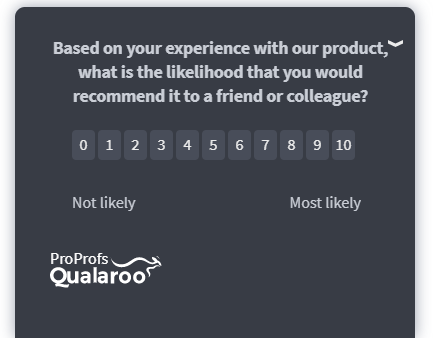
Channel this information through your sales teams to see if you can retain the customer. And send the issues and bugs to your development team for optimization.
For example, if a customer states price as the reason for leaving the product, you can reach out to them with a suitable offer.
Or, if they want a specific feature added to their product, you can customize it individually for their account as a chargeable service. A lot of SaaS-based product companies offer customization services.
Elevating Customer Experience: The Role of Feedback in Product Development
The journey of creating a product is a continuous cycle, enhanced by customer feedback to ensure innovation remains at its core.
This feedback loop allows for engagement with users from the initial idea to the final use, aligning your offerings with their expectations and delivering superior solutions. However, streamlining this process doesn't have to extend timelines.
Modern platforms offering product feedback surveys streamline the collection and analysis of user insights, enabling product teams to integrate this valuable information into their development process swiftly. These tools allow for the gathering of feedback in hours rather than days.
Incorporating product feedback questionnaires into your strategy establishes an ongoing cycle of improvement, boosting product functionality, customer satisfaction, and loyalty.
With the right product feedback survey software, like Qualaroo, deploying these surveys and gleaning actionable insights from the feedback becomes effortless. So, why delay?

